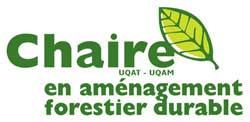
Louis Imbeau est titulaire d'un baccalauréat en biologie (UQAC 1994), d'une maîtrise en ressources renouvelables (UQAC 1996) et d'un doctorat en sciences forestières (Université Laval 2001). Avant de se joindre à l'UQAT en 2002 à titre de professeur en aménagement de la faune, il a réalisé un stage post-doctoral au Groupe de Recherche en Écologie Forestière interuniversitaire (GREFi) à l'Université du Québec à Montréal. Il est membre régulier du Centre d'Étude de la Forêt (CEF) et a siégé comme membre de l’éxécutif de ce centre de sa fondation en 2006 jusqu’en 2012. De 2005 à 2015, il a été membre du Comité scientifique chargé d’examiner la limite nordique des forêts attribuables au Québec.
Le Dr Imbeau est un spécialiste de l'avifaune boréale dont les premiers travaux visaient à comparer les assemblages d'espèces retrouvées dans une chronoséquence post-feux et post-coupes en pessière à mousses. L'identification d'espèces sensibles aux effets cumulatifs de l'aménagement forestier, tant dans l'Est du Canada qu'en Fenno-Scandinavie, ont orienté ses travaux récents à documenter l'importance des vieilles forêts, de la disponibilité de cavités ainsi que du recrutement du bois mort pour diverses espèces fauniques, notamment chez les pics ainsi que chez les petits mammifères. Ses champs d'intérêts en recherche portent principalement sur l'influence des activités de récolte forestière en milieu boréal, tant sur les assemblages d'espèces d'oiseaux et de petits mammifères que sur la faune gibier. Dans un contexte de diversification des activités sylvicoles, il vise à évaluer les avantages potentiels pour la faune de nouvelles approches de récolte de matière ligneuse, notamment l'utilisation de coupes partielles.
Axes de Recherche
- Importance du recrutement de chicots, de cavités et des débris ligneux pour la faune associée aux forêts boréales (i.e. pics et oiseaux utilisateurs secondaires de cavités, petits mammifères et Grand Polatouche).
- Diversification des méthodes de récolte de matière ligneuse en forêt boréale : évaluation des avantages et inconvénients pour la faune-gibier.
- Évaluation et atténuation des impacts associés à des approches de sylviculture intensive sur l'avifaune et la faune-gibier.
Autres sites à consulter :
Site départemental-UQAT Centre d'étude de la forêt (CEF) ResearchGate GoogleScholar ORCID Justine Le Vaillant, Alexandre Terrigeol, Laetitia Desbordes, Pascal Côté, Jérôme Lemaître, Alexandre Anctil, Clara Casabona, Jacques Ibarzabal, Louis Imbeau, Nova Mackentley, Chris Neri, Brian Rolek, Christopher J. W. McClure, Jean-François Therrien. Demographic trends for the Boreal Owl, Aegolius funereus, using standardized migration monitoring data in eastern North America 2025. The Wilson Journal of Ornithology online first
DOI : 10.1080/15594491.2025.2547332
Akib Hasan, Miguel Montoro Girona, Louis Imbeau, Jennifer Lento, Anouschka R. Hof, Guillaume Grosbois. Indicator species reveal the physical and biological singularity of esker ecosystems 2023. Ecological Indicators 110612
DOI : 10.1016/j.ecolind.2023.110612
Mariano Feldman, Marc Mazerolle, Louis Imbeau, Nicole J. Fenton. Occupancy and Abundance of Pond-Breeding Anurans in Boreal Landscapes 2023. Journal of Herpetology 159
DOI : 10.1670/21-080
Osvaldo Valeria, Nicole J. Fenton, Chaima Touati, Louis Imbeau. Projet identification des milieux humides : une approche régionale adaptée à l’Abitibi sur la base des données de télédétection et lidar 2023. Rapport final Chaire AFD 50 p.
Mariano Feldman, Marc Mazerolle, Louis Imbeau, Nicole J. Fenton. Beaver activity and red squirrel presence predict bird assemblages in boreal Canada. 2023. Ornithology 140(2):ukad009
DOI : 10.1093/ornithology/ukad009
Narineme Braham, Osvaldo Valeria, Louis Imbeau. Characterization of Vegetation Dynamics on Linear Features Using Airborne Laser Scanning and Ensemble Learning. 2023. Forests 14(3):511
DOI : 10.3390/f14030511
Philippe Cadieux, Pierre Drapeau, Ugo Ouelet-Lapointe, Alain Leduc, Louis Imbeau, Réjean DesChênes, Antoine Nappi. Old forest structural development drives complexity of nest webs in a naturally disturbed boreal mixedwood forest landscape. 2023. Frontiers in forests and global change 6:1084696
DOI : 10.3389/ffgc.2023.1084696
Pauline Suffice, Marc Mazerolle, Louis Imbeau, Marianne Cheveau, Hugo Asselin, Pierre Drapeau. Site occupancy by American martens and fishers in temperate deciduous forests of Québec. 2023. Journal of mammalogy 104(1):159-170
DOI : 10.1093/jmammal/gyac092
Akib Hasan, Miguel Montoro Girona, Louis Imbeau, Guillaume Grosbois. Les eskers magiques. 2022. Le Couvert Boréal p.11
Osvaldo Valeria, Nicole J. Fenton, Philippe Marchand, Louis Imbeau. Projet identification des milieux humides : une approche régionale adaptée à l’Abitibi sur la base des données de télédétection et lidar. 2022. Rapport d'étape Chaire AFD 20 p.
DOCTORANT
MAîTRISE
STAGIAIRE
2-01. Les fonctions écologiques du bois mort en forêt boréale.
2-03. Adaptation et vulnérabilité des chauves-souris aux pratiques forestières québécoises.
4-13. Sylviculture de régénération et d’éducation de jeunes peuplements mixtes boréaux.
5-09. Caractérisation fonctionnel des milieux humides de l’Abitibi.
2-03. Les fonctions écologiques du bois mort en forêt boréale.
2-07. Adaptation et vulnérabilité des chauves-souris aux pratiques forestières québécoises.
2-10. Effets des routes sur la dynamique de populations d'amphibiens.
2-15. Dynamiques des populations d'amphibiens du Québec entre 1993 et 2013.
2-03. Les fonctions écologiques du bois mort en forêt boréale.
2-08. Adaptation et vulnérabilité des chauves-souris aux pratiques forestières québécoises.
2-11. Effets des routes sur la dynamique de populations d'amphibiens.
2-16. Dynamiques des populations d'amphibiens du Québec entre 1993 et 2013.
2-05. Les fonctions écologiques du bois mort en forêt boréale.
2-10. Importance des arbres à cavités et sélection de l’habitat par le Grand Polatouche.
2-11. Adaptation et vulnérabilité des chauves-souris aux pratiques forestières québécoises.
2-16. Effets des routes sur la dynamique de populations d'amphibiens.
2-21. Dynamiques des populations d'amphibiens du Québec entre 1993 et 2013
2-05. Les fonctions écologiques du bois mort en forêt boréale.
2-10. Importance des arbres à cavités et sélection de l’habitat par le Grand Polatouche.
2-11. Adaptation et vulnérabilité des chauves-souris aux pratiques forestières québécoises.
2-16. Effets des routes sur la dynamique de populations d'amphibiens.
Mariano Javier Feldman, Arnaud Benoit-Pépin, Louis Imbeau, Osvaldo Valeria. Qu’est ce qui explique l’utilisation d’une structure linéaire par les prédateurs du caribou boréal ainsi que son compétiteur apparent? 24e colloque de la Chaire AFD. Université du Québec en Abitibi-Témiscamingue, Rouyn-Noranda, Québec. (2022-11-22)
Akib Hasan, Jennifer Lento, Anouschka R. Hof, Miguel Montoro Girona, Guillaume Grosbois, Louis Imbeau. First characterization of the trophic structure and biodiversity of esker lakes 24e colloque de la Chaire AFD. Université du Québec en Abitibi-Témiscamingue, Rouyn-Noranda, Québec. (2022-11-22)
Narimène Braham, Osvaldo Valeria, Louis Imbeau. Végétation des chemins forestiers : comment le balayage laser aéroporté nous renseigne sur leur état 24e colloque de la Chaire AFD. Université du Québec en Abitibi-Témiscamingue, Rouyn-Noranda, Québec. (2022-11-22)
Arnaud Benoit-Pépin, Louis Imbeau, Osvaldo Valeria, Mariano Javier Feldman. Explication de l'utilisation des structures linéaires par les prédateurs du caribou boréal ainsi que son compétiteur apparent. 15e colloque annuel du CEF, Université de Sherbrooke, Québec (2022-09-29)
Akib Hasan, Miguel Montoro Girona, Louis Imbeau, Jennifer Lento, Guillaume Grosbois. First characterization of the trophic structure and biodiversity of esker lakes 15e colloque annuel du CEF, Université de Sherbrooke, Québec (2022-09-28)
Nathan Chabaud, Louis Imbeau, Marc Mazerolle, Pierre Drapeau, Pauline Suffice, Marianne Cheveau. Habitat selection by fisher (Pekania pennanti) in Quebec deciduous forest 15e colloque annuel du CEF, Université de Sherbrooke, Québec (2022-09-28)
Narimène Braham, Osvaldo Valeria, Louis Imbeau. Caractérisation de la dynamique de végétation des structures linéaires à l'aide du système de balayage laser aéroporté 15e colloque annuel du CEF, Université de Sherbrooke, Québec (2022-09-28)
Mariano Javier Feldman, Louis Imbeau, Marc Mazerolle. Communautés d'amphibiens utilisant des petits étangs du Nord-du-Québec 3e colloque annuel de la Chaire industrielle CRSNG-UQAT sur la biodiversité en contexte minier. Université du Québec en Abitibi-Témiscamingue, Rouyn-Noranda, Québec. (2022-04-22)
Akib Hasan, Miguel Montoro Girona, Louis Imbeau, Jennifer Lento, Anouschka R. Hof, Guillaume Grosbois. Go to the lakes to know the forest biodiversity: The esker project 23e colloque de la Chaire AFD. Université du Québec en Abitibi-Témiscamingue (2021-12-07)
Marcel Darveau, Louis Imbeau. LA CARTE ÉCOFORESTIÈRE ET LES MILIEUX HUMIDES : QUELLES APPLICATIONS POUR LA FAUNE? 8eRendez-vous des ressources naturelles - la gestion des milieux humides et hydriques (2021-05-27)
Louis Imbeau, Émilie Desjardins. Utilisation des parcs a résidus miniers par la sauvagine en comparaison avec des étangs a castors en Abitibi Témiscamingue 3e colloque annuel de la Chaire industrielle CRSNG-UQAT sur la biodiversité en contexte minier. Université du Québec en Abitibi-Témiscamingue, Rouyn-Noranda, Québec. (2021-04-21)
Guillaume Grosbois, Louis Imbeau, Miguel Montoro Girona. The ice age: the responsible of highest level of waterbird and aquatic biodiversity today? 22e colloque de la Chaire AFD. Université du Québec en Abitibi-Témiscamingue, complètement virtuel (2020-12-02)
Arnaud Benoit-Pépin, Louis Imbeau, Osvaldo Valeria. Caribou forestier et la foresterie, à la croisée des chemins 22e colloque de la Chaire AFD. Université du Québec en Abitibi-Témiscamingue, complètement virtuel (2020-12-02)
Narimène Braham, Osvaldo Valeria, Louis Imbeau. Modélisation de la refermeture de la végétation des chemins forestiers en forêt boréale 22e colloque de la Chaire AFD. Université du Québec en Abitibi-Témiscamingue, complètement virtuel (2020-12-02)
Léa Darquié, Vincent Poirier, Louis Imbeau, Patricia Raymond, Benoit Lafleur, Annie DesRochers. Effets du dégagement mécanique sur la croissance, les stocks de carbone et la qualité de l’habitat faunique dans un peuplement mixte 22e colloque de la Chaire AFD. Université du Québec en Abitibi-Témiscamingue, complètement virtuel (2020-12-02)
Chanèle Poirier, Antoine Adde, Marie-Eve Sigouin, Marcel Darveau, Geneviève Labrecque, Louis Imbeau, Jérôme Cimon-Morin. Intégration d’enjeux de gestion durable des milieux humides et riverains en aménagement forestier 21e colloque de la Chaire AFD. Université du Québec en Abitibi-Témiscamingue, Rouyn-Noranda, Québec. (2019-11-30)
Louis Imbeau, Lise Jaton, Osvaldo Valeria, Philippe Marchand, Nicole J. Fenton. Détection des milieux humides : une approche régionale adaptée à l’Abitibi 21e colloque de la Chaire AFD. Université du Québec en Abitibi-Témiscamingue, Rouyn-Noranda, Québec. (2019-11-30)
Pauline Suffice, Louis Imbeau, Hugo Asselin, Marianne Cheveau, Pierre Drapeau. Évaluation des facteurs pouvant expliquer l'augmentation des populations de pékan et la diminution des populations de martre 20e colloque de la Chaire AFD. Université du Québec en Abitibi-Témiscamingue, Lorrainville, Québec. (2018-11-30)
Annick Antaya, Pierre Drapeau, Louis Imbeau, Alain Leduc. Connectivité fonctionnelle et occupation de l’habitat par le Grand Pic en paysage agroforestier boréal 20e colloque de la Chaire AFD. Université du Québec en Abitibi-Témiscamingue, Lorrainville, Québec. (2018-11-30)
Annick Antaya, Pierre Drapeau, Alain Leduc, Louis Imbeau. Affiche 8
Connectivité fonctionnelle et occupation de l’habitat par le Grand Pic en paysage agroforestier boréal 19e colloque de la Chaire AFD. Université du Québec en Abitibi-Témiscamingue, Ste-Germaine-Boulé, Québec. (2017-11-30)
